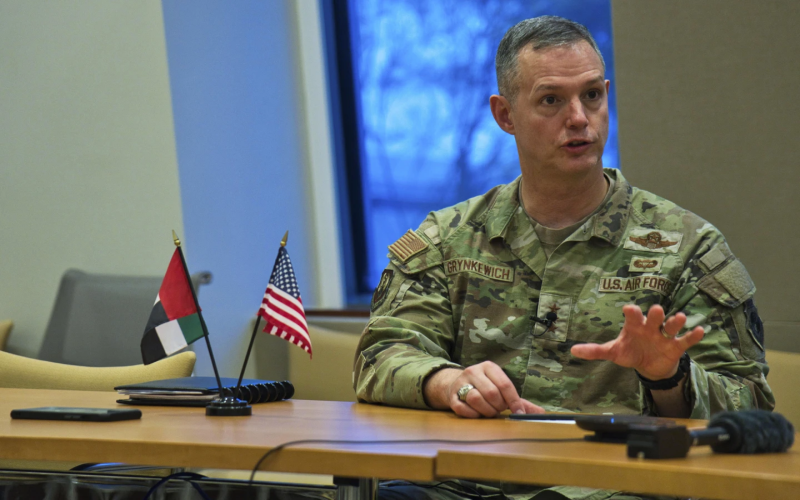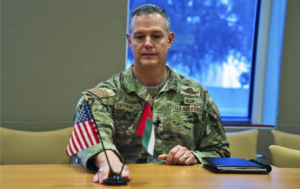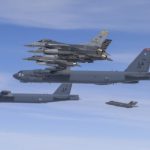
ABU DHABI, United Arab Emirates (AP) — Iran’s supplying of bomb-carrying drones to Russia could see Moscow help Tehran’s program become more lethal, raising risks across the wider Middle East, the top U.S. Air Force commander in the Middle East said Wednesday.
Lt. Gen. Alexus Grynkewich, the head of U.S. Air Force Central, described the danger potentially posed by Russia’s “cooperation and collusion” with Iran as extending from the airspace over Syria, while Tehran threatens commercial ships in the waters of the Persian Gulf.
American pilots have already faced what they describe as more aggressive maneuvers from Russian pilots in Syria, while a new deployment of U.S. air power has been sent to protect commercial shipping in the Gulf’s key Strait of Hormuz, through which 20% of all the world’s oil passes.
“I am concerned about the growing relationship between Russia and Iran and the drones being supplied to Russia,” Grynkewich told journalists during a news conference at the U.S. Embassy in Abu Dhabi. “Who would have ever thought that the Russian Federation would need to go to Iran for military capabilities, and yet we’re there. That means that Russia actually owes Iran something. I’m concerned about the level of collaboration that might happen.”
Iran’s mission to the United Nations and the Russian Embassy in Washington did not immediately respond to a request for comment.
Tehran has offered conflicting explanations about the drones Russia has used to target Ukraine during its war on the country, at times denying arming Moscow while also saying it provided some before the war on Ukraine began. Western nations, Ukraine and experts who have forensically examined the drones link them back to Iran and say their vast number deployed on the battlefield show a constant resupplying by Tehran.

Grynkewich said he was worried that Russian upgrades to Iran’s drone technology could “backwash” to Tehran, making those bomb-carrying devices even more dangerous. And by Russia owing Iran for the munitions, it could return the favor by dialing up the pressure on American pilots who still fly over Syria and Iraq as part of a mission to target the remnants of the Islamic State group.
“There could be some amount of cooperation and collusion between Russia and Iran that’s playing out here in Syria. We’ll see where that goes,” Grynkewich said. “It is something that we watch very closely. That burgeoning relationship is of a military concern to me.”
Meanwhile, Russian pilots over recent months have been aggressive in flying close to both manned F-35 fighter jets and drones over Syria. The Air Force publicly showed a Russian pilot dumping fuel on a drone and trying to set it alight with flares.
But Grynkewich described some of that behavior as dialing back in recent weeks.
“I’m not attributing causality to the fact that we called them out, but by showing the unprofessional nature of their behavior since that time, they do still intercept our MQ-9 (drones) from time to time, but it is in a much safer manner,” he said. “I would still characterize it as unprofessional because it is not in accordance with established rules that we have where we stay certain distances apart, but it is safe at this time.”
The U.S. and Russia still operate what America calls a “deconfliction line” to make sure their aircraft don’t run into each other or come too close. Grynkewich described 90% of the calls as routine, though 10% can involve issues where the countries vigorously dispute each others’ actions over Syria, which still remains mired in its yearslong war.
“You do get into some heated exchanges,” Grynkewich said. “Those exchanges, while heated, are always professional between the two sides.”
Meanwhile in Syria, Grynkewich said that “hundreds” of fighters from the Russian mercenary group Wagner still operate in the country, even after their leader Yevgeny Prigozhin died in a mysterious, fiery plane crash following his march on Moscow challenging Russian President Vladimir Putin.
“We have seen, as you might expect, some tension between those forces and the Russian forces that are there,” Grynkewich said. “For the most part, it appears that they have come to some sort of an agreement … (and) they’ll continue to operate together to meet the objectives of the Russian Federation there in Syria.”
In recent weeks, a major deployment of U.S. sailors and Marines, alongside F-35s, F-16s and other military aircraft, has been underway in the Persian Gulf region over concerns about Iran targeting shipping. The Pentagon also is considering a plan to put U.S. troops on board commercial ships in the Strait of Hormuz.
Grynkewich said that flexible deployment likely would remain for some time, backed up by the extensive network of bases America enjoys across the region.
“Part of our approach here in the Middle East was to be able to surge forces into the region when the threat warrants,” he said. “It is an enduring commitment here to the region. We are not going anywhere.”
But there has been growing concern, as the Biden administration entered office, about deploying too many forces into the Middle East after the wars in Afghanistan and Iraq when Washington sees a growing threat in China and Russia. Asked about the mission to counter the Islamic State group, Grynkewich said he could see it potentially winding down.
“We’re kind of at the last phase of the operation where we’re trying to set conditions now for normalizing relationships that will allow pressure to remain on ISIS, but not to have to have a full task force,” Grynkewich said, using an acronym for the extremist group. “When exactly that transition happens, it’s really not mine to say but I think within the next few years we certainly will see adjustments to how things play out.
Newsroom | theworldmail.co.uk
Source/Contribution/Photo Credit by Associated Press
ASSOCIATED PRESS | For more about AP, please visit ap [dot] org






